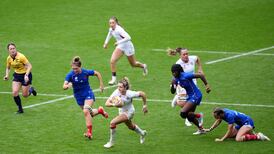Ireland will know what lies ahead in the 2019 World Cup when the pool draw for the competition in Japan is made in Kyoto on Wednesday (9am Irish time).
As the world’s fourth ranked team, Ireland will avoid New Zealand, England and Australia who comprise the top tier, but band two offers some fiendishly difficult fixtures.
All-Six Nations encounters with Wales, Scotland and France are possible, as is a heavyweight showdown with South Africa.
And the team that no coach of the top eight ranked countries will want to face lurks in band three — the team who knocked us out of the 2015 World Cup, Argentina — with Japan and Fiji also present.
England will be hoping to escape inclusion in another pool of death, two years ago the toughest group in the competition’s history was created when England were drawn alongside Wales, Australia and Fiji with Uruguay completing the line-up.
Even home comforts could not prevent them from succumbing to a group exit — the first time the hosts have exited the World Cup before the knockout phase.
While the 2015 event’s pool of death is impossible to repeat, danger lurks within the three top bands of seeds from which the heavyweights will be drawn.
England are also present in the top band and so face the same possible opponents as Ireland, while Wales and Scotland are confronted with the possibility of a group showdown with New Zealand.
The All Blacks are seeking to lift the Webb Ellis Trophy for a third successive time and predictably enter the tournament as strong favourites, although the British and Irish Lions have the opportunity to put a dent in their self-belief during the looming tour.
The sport will be hoping for an improvement from South Africa and Australia, two powerhouses of the game who have struggled since England 2015 but who have the firepower to make an impact if they are able to rally.
How does it work?
There will be four pools of five teams drawn, one from each of the five bands for each pool.
Twelve teams directly qualified by virtue of their finish at the 2015 World Cup. Eight teams are not yet known.
The seedings and bands were based on the world rankings at the end of the Six Nations.
Seeds
Countries listed in order of seeding with method of qualification and best World Cup performance (number indicates world ranking)
BAND ONE
1. New Zealand
Directly qualified as 2015 champions
Also champions 1987 and 2011
2. England
Directly qualified with third-place in Pool A in 2015
Champions 2003
3. Australia
Directly qualified as 2015 runners-up
Champions 1991 and 1989
4. Ireland
Directly qualified as 2015 quarter-finalist
Quarter-finalist six times
BAND TWO
5. Scotland
Directly qualified as 2015 quarter-finalist
Semi-finalist in 1991
6. France
Directly qualified as 2015 quarter-finalist
Runners-up in 1987, 1999 and 2011
7. South Africa
Directly qualified as 2015 semi-finalist
Champions 1995 and 2007
8. Wales
Directly qualified as 2015 quarter-finalist
Semi-finalist in 1987 and 2011
BAND THREE
9. Argentina
Directly qualified as 2015 semi-finalist
Also semi-finalist in 2007
10. Japan
Directly qualified with third-place in Pool B in 2015
Never past the pool stages
11. Georgia
Directly qualified with third-place in Pool C in 2015
Never past the pool stages
12. Italy
Directly qualified with third-place in Pool D in 2015
Never past the pool stages
BAND FOUR
Oceania 1
Highest ranked team from Pacific Nations Cup 2016 and 2017 (Fiji, Samoa or Tonga)
Europe 1
Highest-ranked team, excluding Georgia, from the Rugby Europe Championship
Americas 1
Winner of United States/Canada playoff
Oceania 2
Second-highest ranked team from Pacific Nations Cup 2016 and 2017 (Fiji, Samoa or Tonga)
BAND FIVE
Africa 1
Winner of the Rugby Africa Championship
Americas 2
Loser of United States/Canada playoff plays top-ranked South American team after Argentina
Playoff winner
Third-placed team from Oceania (Fiji, Samoa or Tonga) plays second highest-ranked team, excluding Georgia, from the Rugby Europe Championship.
Repechage winner
Four teams from around the world who have lost out in other categories play in round-robin format.
Where can I watch the draw?
We will be live blogging the draw on irishtimes/sport.com.
The Rugby World Cup draw will be broadcast live via World Rugby's suite of digital and social media platforms (www.rugbyworldcup.com and @rugbyworldcup Twitter and Facebook), starting at 9am.
The draw will also be live on eir Sport.
Venues
- Sapporo Dome, Sapporo City
- Kamaishi Recovery Memorial Stadium, Iwate Prefecture/Kamaishi City
- Kumagaya Rugby Ground, Saitama Prefecture/Kumagaya City
- New National Stadium Japan, Tokyo
- International Stadium Yokohama, Kanagawa Prefecture/Yokohama City
- Ogasayama Sports Park Ecopa Stadium, Shizuoka Prefecture
- Toyota Stadium, Aichi Prefecture/Toyota City
- Hanazono Rugby Stadium, Osaka Prefecture/Higashi Osaka City
- Kobe City Misaki Park Stadium, Kobe City
- Hakatanomori Football Stadium, Fukuoka City
- Kumamoto Prefectural Athletic Stadium, Kumamoto Prefecture/Kumamoto City
- Oita Stadium, Oita Prefecture
D-Day
Also being decided upon on Wednesday in Japan, the sport's governing body will vote – 32 countries and 48 votes to be cast – on player eligibility rules.
Former Argentina scrumhalf Agustin Pichot, now vice-chairman of World Rugby, has been an outspoken advocate of moving the residency qualification rules for players from three to five years. He’s got significant support including from his chairman Bill Beaumont.
France, England and South Africa are among the countries who are believed to be in favour of extending the qualification period while Scotland are reputed to be opposed to an additional two years being tagged on.
The likelihood is that those supporting Pichot and his stance will be successful. One relevant aspect of any potential change will be when the rule comes into effect. A 75 per cent majority is required.








